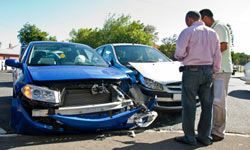Let's play a game of "what if." Say you buy a brand-new car, and one week after buying it -- with that unmistakable new car smell still filling your nostrils -- you get in a nasty accident and total the car. (We know, we know: You're an impeccable driver, and that sort of thing would never happen to you, but just play along.) As everyone knows, a new car loses value the minute it leaves the lot; according to some estimates, a new car depreciates by 9 to 11 percent in the first day. So, if you took out a loan to buy your now-totaled car, chances are you owe more than the car is actually worth [source: Edmunds.com].
If the car owner in this scenario didn't have GAP insurance, they'd have to continue making payments on a totaled car in order to pay off the outstanding debt. How absurd! That's where GAP insurance comes into play. GAP insurance covers the difference between what a car owner owes and what his or her car is actually worth, and in some cases, it covers regular auto insurance deductibles, as well. So, instead of continuing to make payments on a car that's in the junkyard, GAP insurance swoops in and wipes the slate clean.
Advertisement
Why are we capitalizing GAP? It's actually an acronym that stands for "Guaranteed Auto Protection." The guarantee is that in the event of a total loss, GAP insurance will cover your financial obligations, and leave you free to start hunting for a new car, bike, scooter or whatever you choose as your replacement vehicle.
GAP insurance isn't for everyone, though. In fact, there are only a few circumstances (like the one outlined above) in which it would make sense to have GAP insurance. For a more detailed look at who does and doesn't need GAP insurance, and how much it can end up costing you, keep reading.
Advertisement



